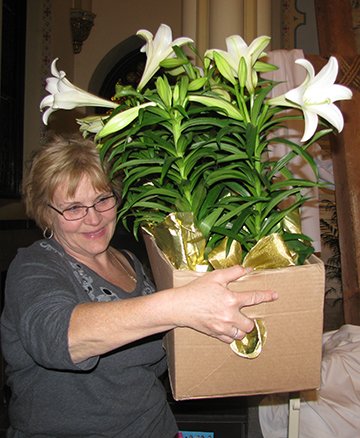Flower ministry is a labor of love
by Sheila Myers
Michael Rebout took a much-needed rest Easter Monday.
As a flower minister for the Cathedral of St. Peter in Kansas City, Kan., he had made it through another Holy Week, the most demanding time of the year because of all the decorating changes.
It all starts with Palm Sunday.
“You have to take everything down from Lent and put up the red,” he said. “Then after Palm Sunday, you take down the red and, for three days, you’re back to purple.”
Then comes the Easter Triduum.
“After putting things away from Holy Thursday, I got things out for Good Friday,” Rebout continued. “After our Good Friday service was over Friday night, we got ready for Easter Vigil.”
Rebout made several more trips Saturday and Sunday to water and trim the plants. He logged more than 25 hours in Holy Week, and that’s not counting the efforts of the other eight volunteers who helped, including his wife Terry.
The flower ministry is no bed of roses.
For Rebout and others who perform this beautiful ministry, it’s a labor of love.
Learning what works
Working with flowers is not just a ministry for Michael and Terry Rebout . . . it’s their livelihood. The Rebouts have owned and operated Michael’s Heritage Florist in Kansas City, Kan., for 39 years.
Michael Rebout never tires of flowers. He finds them therapeutic, and even rises early during the summer to tinker in his own flower garden before going to work.
“I love flowers!” he said. “I always have. They are never boring.”
The Rebouts’ passion for and knowledge of flowers benefits their ministry with the Cathedral.
If they run short of lilies or poinsettias, they can tap into their pool of suppliers. And with almost 40 years of floral experience, Michael Rebout knows what works.
“I like hearty flowers — like carnations, mums and daisies — that tolerate the church heat,” he said.
He’s also had success using kalanchoe, a tropical succulent with tiny flowers in light pink, dark pink and white. It, too, holds up under the harsh conditions of the church.
He loves to try new things.
Several years ago, he switched his decorating strategy. Instead of spreading dozens of small plants on the sanctuary floor for the big holidays, he created and installed huge planters, called “gardens.”
“Everybody liked them because they were up off the floor and people weren’t tripping over them,” Rebout said.
The gardens are now a routine part of their Christmas and Easter decorations.
Many hands
While flowers are a livelihood and a passion for the Rebouts, others come to the flower ministry by chance.
Sarah Devore first volunteered to do the flowers at Ascension Church in Overland Park 13 years ago. She recruited her friend, Becky Reed, to be her co-chair eight years ago.
Rosie Guetterman has been in charge of the flower ministry at Queen of the Holy Rosary in Wea since 1996, when former pastor Father Tony Lickteig asked her to get the church ready for Christmas.
“I think he thought I was a person who wouldn’t say no,” said Guetterman.
She wouldn’t have lasted this long without the help of many volunteers, including her husband Paul and the students and families of the parish, especially during Christmas and Easter.
They’ll do just about anything Guetterman asks: climbing a 25-foot ladder to decorate pillars with Christmas garland, or balancing precariously on a side altar to plug in some Christmas lights.
“I love the people on the committee with me,” Guetterman said. “They’re wonderful.”
Devore calls on a core team of about 10 people to keep the decorations going at Ascension.
“It’s hit or miss [with the volunteers], but it always seems to work out,” she said. “I have a committee and put notices in the bulletin. Sometimes we get students looking for service hours. Men come, but usually it’s the women.”
Ascension volunteers spent four hours the Saturday before Christmas setting up the crèche and placing dozens of poinsettias, azaleas and green ivy plants throughout the church. The volunteers returned to help with the Holy Week decorations.
Keeping it fresh
The volunteers help with the physical labor, but the leaders take care of the planning and purchasing.
Devore and Reed meet throughout the year to brainstorm ideas, always mindful of their limited funds.
“It’s a well-oiled machine that operates like clockwork,” said Devore. “We have a budget for the year and we always stay within our budget.”
Funds for the flower ministry come primarily from Christmas and Easter memorial donations. The donations usually raise enough to cover expenses.
But flower ministers are also experts at stretching those dollars.
The Rebouts pass on volume discounts they get for their business. Devore uses her architecture background to improvise new uses for existing items.
Flower ministers also try hard to prolong the life of the plants by keeping them generously watered.
A few years ago, Devore purchased a 16-gallon mobile watering machine to accomplish this task.
“It’s saved hours and hours of time,” said Devore. “It was well worth the investment.”
Michael Rebout uses a more practical method.
“I have a five-gallon pickle bucket and a big QT cup I carry around,” he said, laughing.
With all the details to tend to, especially during Holy Week, Devore likens flower ministers to a props crew setting up for a never-ending play.
“It’s one thing after another,” Devore said. “Easter is a big thing. Then it’s a gradual transition until Pentecost.”
After Pentecost, everything comes down and the season shifts to Ordinary Time with simple decorations, such as banners and votives. Aside from some minor color changes in the fall, the decorations don’t change much until Advent, when the whole cycle starts again.
With all the repetition in the calendar, flower ministers try to keep the decorations looking fresh to keep parishioners engaged in the liturgy.
“You want the environment to draw people in,” said Guetterman.
Is it worth it?
Flower ministry is a big commitment that puts demands on people’s time when they often have family commitments to tend to. With all the decorating to do at the church, the Guettermans barely had time to put up their own decorations.
Despite the commitment, flower ministers exude a sense of pride.
“It’s a responsibility, but it’s gratifying to see the church so beautiful,” said Guetterman. “This is home. My husband and I are both born and raised in the parish.”
Even though parishioners may not express their gratitude for the beautiful environment, flower ministers know their efforts enhance the worship experience.
“The environment of the church is very, very important because it does create that surrounding in which the liturgy is celebrated,” said Ascension pastor Msgr. Tom Tank. “The people really appreciate it when their church is decorated in a fitting way.”
Knowing what’s “fitting” is key to a good flower minister, who must be able to draw the line between being reverent and being showy.
“I don’t think it’s a question of how much,” Msgr. Tank added. “I think there’s a certain beauty in simplicity, a simple elegance that can enhance the celebration.”
Successful flower ministers understand this distinction. Father Harry Schneider, pastor of the cathedral, has so much confidence in Michael Rebout’s judgment that he gives him free rein over the decorations.
“Sometimes I make suggestions, but he is so talented and has such good taste and a real understanding of liturgy that I trust him completely,” said Father Schneider.







